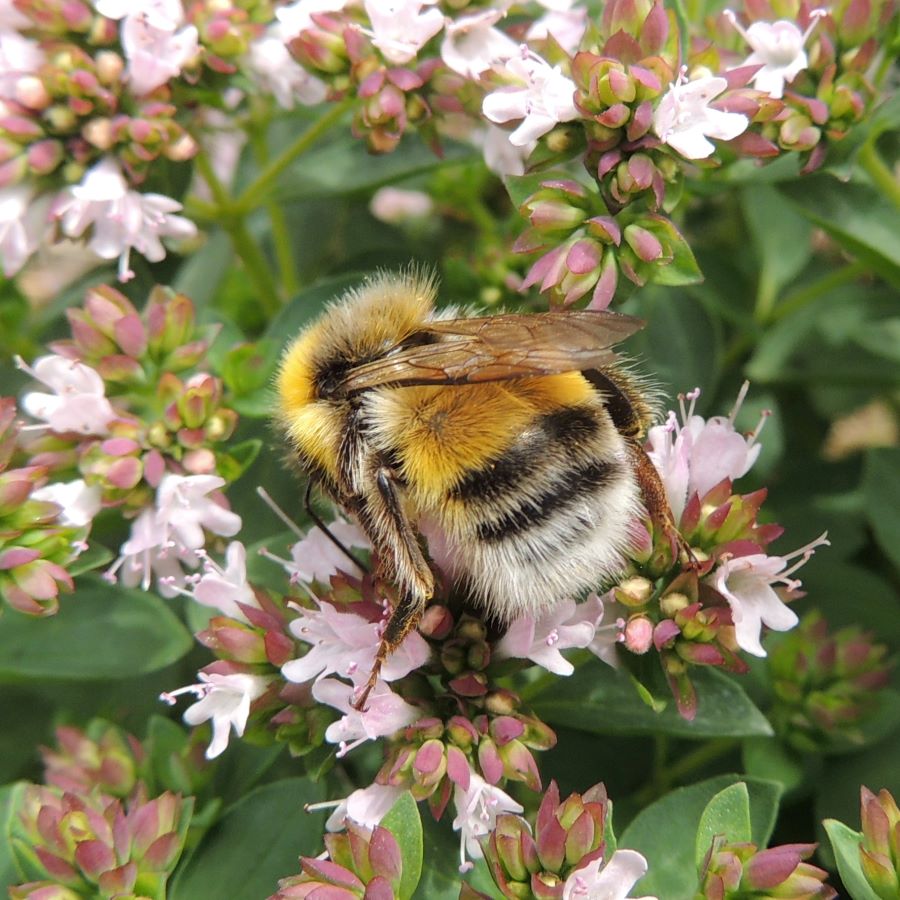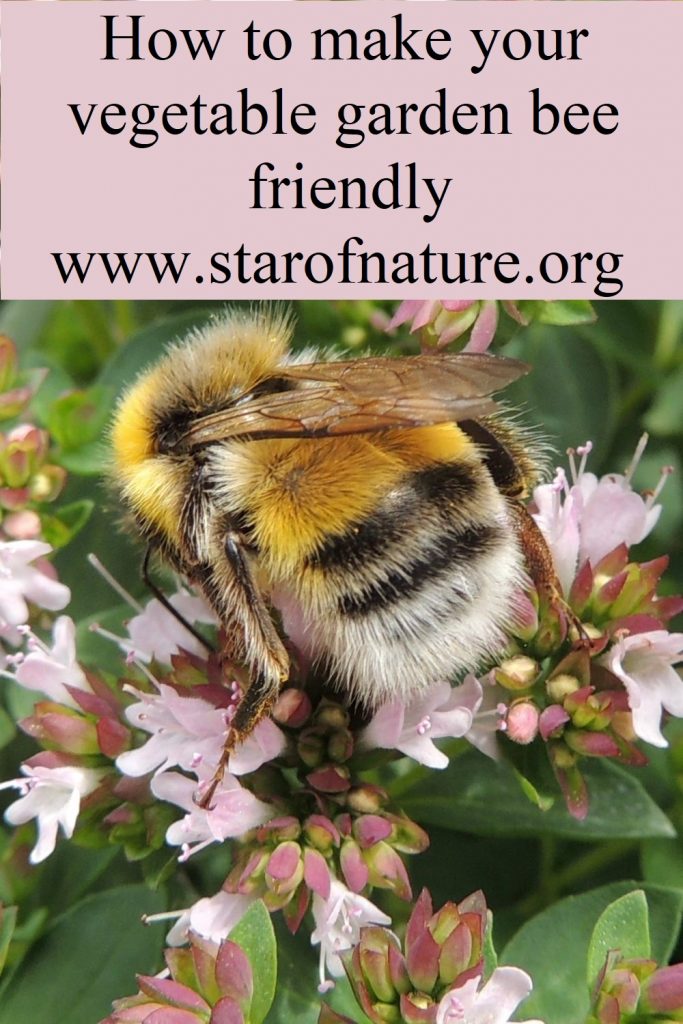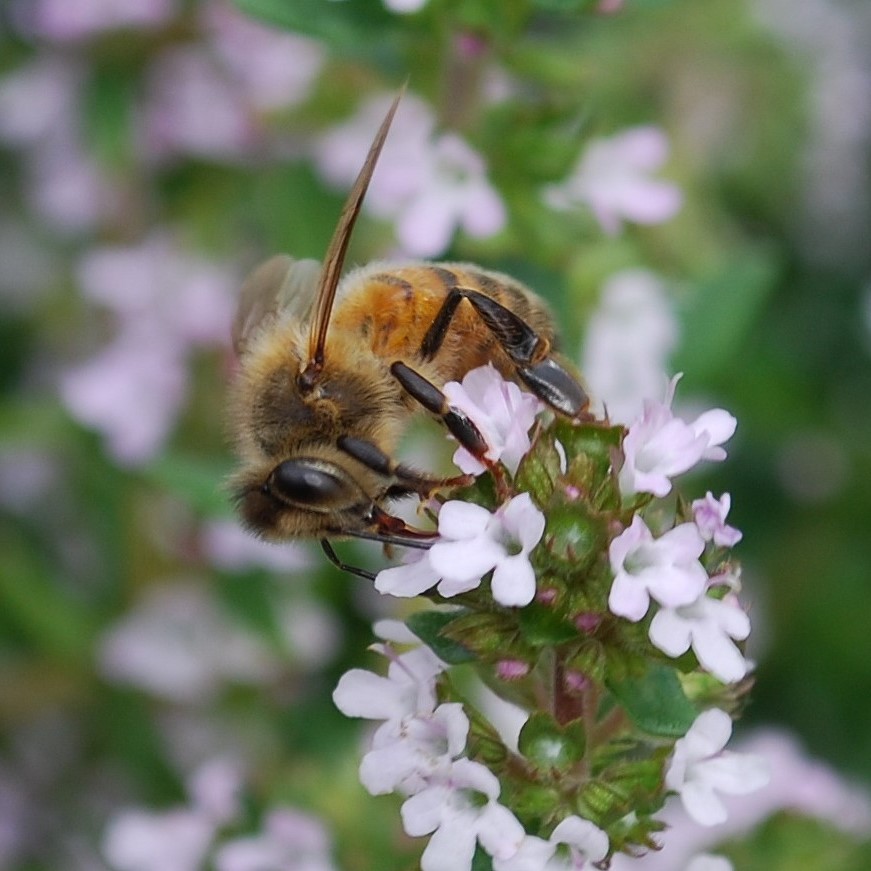How to Make your Vegetable Garden Bee Friendly
There are a several simple steps you can take to make your vegetable garden bee friendly:
1. Do not use insecticides, herbicides and fungicides that are harmful to bees.
2. Create places for bees to live by installing insect houses and beehives.
3. Grow vegetables with nectar-rich flowers that provide food for bees.
4. Grow wild greens that can be used as vegetables and have pollen- and nectar-rich flowers.
5. Rewild a part of your garden to create a wildlife-friendly environment.
6. Grow nectar-rich phacelia for soil improvement.
7. Use companion planting, combining mutually beneficial vegetables and flowers.
Below I explain each of these steps in more detail.
The importance of bees in a vegetable garden
When planning a vegetable garden it is essential not to forget about pollinators. Without them plants will be much less productive. The majority of plants either entirely depend on cross-pollination, or produce much better fruit as a result of cross-pollination, rather than self-pollination. Cross-pollination happens when a plant receives pollen not from itself, but from another plant of the same species.
Pollen can be carried from flower to flower by the wind, but this is enough only for plants that evolved to be pollinated by wind. Such plants, including pine or grasses, for example, produce huge amounts of pollen that is very light and literally saturates the air. For other plants with heavier pollen, produced in smaller quantities, insects are by far the most effective pollinators.
In exchange for their services plants provide insects with food, including pollen that is rich in protein and nectar that is rich in carbohydrates. Of all the insects honey bees visit the largest number of flowers and so play the biggest role in pollination. They are therefore essential companions of a fruit and vegetable garden, and so when creating one, it is important to think how to attract them.

1. Use organic, chemical-free gardening methods
This is an absolutely essential step. Pesticides, herbicides and fungicides kill insects and harm human health as well. Particularly harmful for bees is the application of chemicals during the flowering of plants. Bees get poisoned by nectar and pollen collected from plants sprayed with chemicals.
There is evidence that some of the most serious conditions affecting bees, including the Colony Collapse Disorder (CCD), are a result of the use of agricultural chemicals. The cause of CCD is believed to be neonicotinoids, insecticides that function as neurotoxins. They are either banned or restricted for outdoor use in several countries.
2. Install insect houses, bumble bee nests and beehives
You could welcome bees in your garden by providing places for them to live. It is possible to buy inexpensive insect houses and bumble bee nests in different designs.
For a large garden it is worth considering installing a conservation hive for wild bees, or learning organic, low-interference bee-keeping.
Read my review of Les Crowder and Heather Harrell, ‘Top-Bar Beekeeping: Organic Practices for Honeybee Health’, the best and the most detailed introduction to organic top-bar beekeeping currently available.

3. Grow bee friendly plants in a vegetable garden
When we think of growing pollinator-friendly plants, we tend to think of decorative flowers. They do have an important part to play in supporting pollinators, but the role of a fruit and vegetable garden tends to be greater.
This is partly because many flowers, commonly grown in decorative gardens, have been bread for size, bright colours and striking shapes, but as a result lost their smell and their ability to produce nectar and pollen. Thus, the majority of double flowers have little to offer to bees. Bees eagerly visit roses with single flowers, such as wild and some climbing roses, but the majority of roses, grown as decorative plants, are double and produce little food for bees.
And on the contrary, the majority of fruit trees and shrubs are excellent for pollinators. Spring flowering of cherries, apples, pears, plums, almonds, peaches, currants, and other orchard plants, provides bees with abundant food. And in the summer the long flowering of raspberries and blackberries is also hugely important for bees.
The majority of plants in a vegetable garden flower in the summer which is the most important time for bees. By midsummer their colonies are at their strongest, and this is the time when they collect most of their winter stores.
Some of the best vegetables for bees are listed below.
Broad beans
Broad beans produce masses of delicately scented flowers that are eagerly visited by bees. They have an advantage of flowering early, before the majority of plants in a vegetable garden.
Chives
Flowers of all members of the allium family, including chives, onions, garlic and decorative alliums, are very rich in nectar and attract numerous bees. They continue to produce nectar even in very dry hot whether, when nectar production of most plants slows down or comes to a halt. Chives have beautiful purple flowers that usually appear in June.

Cucumbers, courgettes, pumpkins and melons
Cucumbers, courgettes, pumpkins and melons have separate male and female flowers, and so cannot self-pollinate. There is a small number of cultivars that produce seedless fruit without pollination. Such fruit is grown in hot houses and other environments without bees, and is believed to be of inferior eating quality.
The majority of plants of the gourd family (Cucurbitaceae) require pollination, and pollen needs to be carried from flower to flower by insects. Without pollinators gourds are unable to produce fruit. This occasionally happens if wet weather or cold early in the season prevent bees from visiting flowers. Fruit that has been only partially pollinated grows asymmetrical and contains a small number of poor quality seeds.
All cucurbitaceae produce an abundance of nectar and pollen. Bright yellow colour of their flowers, combined with a large size in the case of courgettes and pumpkins, helps to attract insects.
Pumpkin flowers are particularly rich in nectar and continue to produce it even in very dry and hot weather. Sometimes they can be seen with several bees working inside. Bees entirely cover themselves in plentiful pollen and later carry it to female flowers.
Coriander and angelica
Coriander and angelica are some of the best nectar producers of the Umbelliferae family. Both flower in the middle of summer, have a strong honey-like smell, and are very attractive to bees. Angelica is also a beautiful stately plant that can be grown in a decorative garden.
Mint, oregano, winter savory, thyme, sage, hyssop and basil
These plants of the mint family (Labiatae) are exceptionally important for insects. Their flowers are constantly covered with bees in July, August and September. Of all the plants in my garden, including trees, climbing roses and decorative flowers, these wonderful herbs are definitely the winners – they are most frequently visited by bees.
Try to grow more of them, particularly since they are very undemanding and, apart from basil, tolerate poor soil and dryness. It is amazing how much life they can bring to the garden.

Nigella and borage
Nigella and borage are both attractive, and can be grown as decorative plants. Both self-seed easily and, once sown, will persist in the garden, even on poor soil.
Nigella is frequently visited by bees. Its seeds are also a nutritious spice. Nigella (black seed) oil is widely used for cooking and as a health supplement. Its seeds are not difficult to collect, since huge numbers of them are stored in large easy-to-see and handle seed heads.
Borage is among the best nectar producers. One of its advantages is its very long period of flowering – it blooms almost the entire summer and autumn, until the start of hard frosts. Deadheading it by removing spent flower heeds in August ensures that flowering continues in autumn.
Borage is an excellent salad plant. Its young leaves are tender and have a mild taste, and a smell that resembles cucumber.
4. Grow wild salad greens
Many wild plants are perfect salad vegetables and can be cooked in the same way as spinach. They offer new tastes and textures and are highly valued by amateur and professional chefs. Moreover, numerous studies have shown that wild plants are superior to cultivated plants in terms of nutrition. They therefore ideally should be a regular part of everyone’s diet. They also tend to be good nectar and pollen producers.
Wild plants that are beautiful, can be used as vegetables or spice, and are an excellent source of pollen and nectar for bees include wild chicory, elecampane and wild garlic.
5. Rewild a part of your garden
Small scale rewilding, that I described in a different post, involves several steps aimed at creating a balanced and self-regulating ecosystem in the garden. The most important of these steps is rewilding the soil. It restores it as a living biological community, and enables it to feed the plants without artificial fertilizers.
Abandoning chemicals and some intensive techniques, such as frequent lawn mowing, has a disproportionally beneficial affect on the entire garden. If you switch to organic gardening and reserve some of your lawn for wild flowers, it will attract beneficial insects, including bees, to your garden.
6. Grow phacelia for soil improvement
Phacelia is often grown as ‘green manure’. It is sown in cleared vegetable beds in late summer or early spring, and then cut down and left on the beds as mulch. This is excellent for the soil, but unfortunately this usually does not give phacelia enough time to flower. And this is a pity, because phacelia is one of the most nectar-rich plants in existence. It is difficult to find its rival as a food source for insects. When it flowers, it is constantly covered with bees that collect both its nectar and its blue pollen.
It you have enough space in your garden, it is a great idea to leave phacelia for longer, so that it could flower and be used as mulch after it has completed its life cycle. It has an amazingly positive impact on soil both as mulch and due to its roots that loosen the soil. It is also very beautiful when it flowers. And without any doubt it will help pollinators and attract them to your garden.
7. Using companion planting
Companion planting is an organic method of pest control. Many insects, that normally feed on vegetables, are confused and deterred by a strong smell of such plants as marigolds (tagetes) and calendula. For this reason these flowers are often planted side by side with vegetables.
Generally, avoiding monoculture helps to avoid problems. Alternating planting of different vegetables and flowers is therefore a good strategy.
Marigolds and calendula, most commonly used as companions to vegetables, are also good for insects. Choose, however, single, rather than double varieties of both – they are just as beautiful. Both marigolds and calendula are medicinal, can be used as spices and in home-made cosmetics, and look wonderful in flower arrangements.
Read more about companion planting: Companion Planting for Vegetables in an Organic Garden.
Image credits: featured image – honeybee on thyme by Jon BeesinFrance, Snowshill Manor garden by Karen Roe.
Posts related to ‘How to Make your Vegetable Garden Bee Friendly’
What is Nectar: Basics for a Bee-Lover
What is Pollen: Basics for a Bee-Lover
What are the Best Nectar-Producing Flowers for Bees?
Best Wild Flowers for Bees and Butterflies
Lemon Balm or Melissa – What does it Do for Bees?
Organic Pest Control: Sanctuaries for Beneficial Insects
Pin ‘How to Make your Vegetable Garden Bee Friendly’ for later

